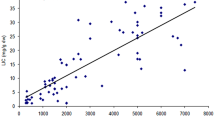Abstract
Thalassemia major (TM) is a hereditary disease caused by defective globin synthesis. Because of the significant increase in life expectancy, these patients are suffering from various health conditions, including endocrinopathies and low bone mineral density. The aim of the present study was to investigate the correlation between clinical and biochemical parameters as well as to identify possible relations in a genotype to phenotype pattern. Sixty-four patients with TM (32 men and 32 women) participated in a cross-sectional study design. The patients were recruited from “Aghia Sofia” Children’s Hospital. Clinical and biochemical parameters were evaluated as well as specific mutations were identified. We have found significant correlations between biochemical parameters and iron chelation, hormone replacement treatment as well as TM genotype and hematocrit and T-score. To conclude, the current study showed that clinical parameters of TM patients correlate significantly with both biochemical factors and genotypical patient parameters. Our present study showed that there is a connection between genotype and phenotype as, for example, the identified relation between hematocrit and T-scores and TM-specific mutations. This connection indicates that there is still much more to learn about the role of mutations not only in the disease itself but also in the underlying comorbidities.
Access this chapter
Tax calculation will be finalised at checkout
Purchases are for personal use only
Similar content being viewed by others
References
Cousens NE et al (2010) Carrier screening for beta-thalassaemia: a review of international practice. Eur J Hum Genet 18(10):1077–1083. https://doi.org/10.1038/ejhg.2010.90
Lee YK et al (2019) Recent progress in laboratory diagnosis of thalassemia and hemoglobinopathy: a study by the Korean Red Blood Cell Disorder Working Party of the Korean Society of Hematology. Blood Res 54(1):17–22. https://doi.org/10.5045/br.2019.54.1.17
Goh SH et al (2005) A newly discovered human alpha-globin gene. Blood 106(4):1466–1472. https://doi.org/10.1182/blood-2005-03-0948
Karponi G, Zogas N (2019) Gene therapy for beta-thalassemia: updated perspectives. Appl Clin Genet 12:167–180. https://doi.org/10.2147/tacg.s178546
Weatherall DJ, Clegg JB (1999) Genetic disorders of hemoglobin. Semin Hematol 36(4 Suppl 7):24–37
Weatherall DJ (1994) The thalassemias. In: Stamatoyannopoulos G, Nienhuis AW, Majerus PW, Varmus H (eds) The molecular basis of blood diseases. WB Saunders, Philadelphia, p 815
Otrock ZK et al (2006) Intravenous zoledronic acid treatment in thalassemia-induced osteoporosis: results of a phase II clinical trial. Ann Hematol 85(9):605–609. https://doi.org/10.1007/s00277-006-0136-y
Dresner Pollack R et al (2000) Bone mineral metabolism in adults with beta-thalassaemia major and intermedia. Br J Haematol 111(3):902–907
Molyvda-Athanasopoulou E et al (1999) Bone mineral density of patients with thalassemia major: four-year follow-up. Calcif Tissue Int 64(6):481–484
Voskaridou E et al (2006) Osteoporosis and osteosclerosis in sickle cell/beta-thalassemia: the role of the RANKL/osteoprotegerin axis. Haematologica 91(6):813–816
Tsartsalis AN et al (2018) The role of biphosphonates in the management of thalassemia-induced osteoporosis: a systematic review and meta-analysis. Hormones (Athens) 17(2):153–166. https://doi.org/10.1007/s42000-018-0019-3
Tsartsalis AN et al (2019) Bone metabolism markers in thalassemia major-induced osteoporosis: results from a cross-sectional observational study. Curr Mol Med 19(5):335–341. https://doi.org/10.2174/1566524019666190314114447
Spatz JM et al (2015) The Wnt inhibitor sclerostin is up-regulated by mechanical unloading in osteocytes in vitro. J Biol Chem 290(27):16744–16758. https://doi.org/10.1074/jbc.M114.628313
McClung MR et al (2014) Romosozumab in postmenopausal women with low bone mineral density. N Engl J Med 370(5):412–420. https://doi.org/10.1056/NEJMoa1305224
van Dinther M et al (2013) Anti-Sclerostin antibody inhibits internalization of Sclerostin and Sclerostin-mediated antagonism of Wnt/LRP6 signaling. PLoS One 8(4):e62295. https://doi.org/10.1371/journal.pone.0062295
Cosman F et al (2016) Romosozumab treatment in postmenopausal women with osteoporosis. N Engl J Med 375(16):1532–1543. https://doi.org/10.1056/NEJMoa1607948
Reynolds AW et al (2018) Comparison of osteoporosis pharmacotherapy fracture rates: analysis of a MarketScan((R)) claims database cohort. Int J Endocrinol Metab 16(3):e12104. https://doi.org/10.5812/ijem.12104
Bordbar M et al (2019) Effect of different iron chelation regimens on bone mass in transfusion-dependent thalassemia patients. Expert Rev Hematol 12(11):997–1003. https://doi.org/10.1080/17474086.2019.1662721
Eghbali A et al (2019) A 1-year randomized trial of deferasirox alone versus deferasirox and deferoxamine combination for the treatment of iron overload in thalassemia major. Transfus Apher Sci 58(4):429–433. https://doi.org/10.1016/j.transci.2019.03.021
Tanner MA et al (2007) A randomized, placebo-controlled, double-blind trial of the effect of combined therapy with deferoxamine and deferiprone on myocardial iron in thalassemia major using cardiovascular magnetic resonance. Circulation 115(14):1876–1884. https://doi.org/10.1161/circulationaha.106.648790
Soliman A et al (2014) Growth hormone – insulin-like growth factor-I axis and bone mineral density in adults with thalassemia major. Indian J Endocrinol Metab 18(1):32–38. https://doi.org/10.4103/2230-8210.126525
Bhardwaj A et al (2016) Treatment for osteoporosis in people with β-thalassaemia. Cochrane Database Syste Rev 3:CD010429. https://doi.org/10.1002/14651858.CD010429.pub2
Vogiatzi MG et al (2006) Prevalence of fractures among the Thalassemia syndromes in North America. Bone 38(4):571–575. https://doi.org/10.1016/j.bone.2005.10.001
Chen YG et al (2018) Risk of fracture in transfusion-naive thalassemia population: a nationwide population-based retrospective cohort study. Bone 106:121–125. https://doi.org/10.1016/j.bone.2017.10.016
Stefanis L et al (1994) Hematologic phenotype of the mutations IVS1-n6 (T→C), IVS1-n110 (G→A), and CD39 (C→T) in carriers of beta-thalassemia in Greece. Pediatr Hematol Oncol 11(5):509–517. https://doi.org/10.3109/08880019409141689
Allon R et al (2018) How to best predict fragility fractures: an update and systematic review. Isr Med Assoc J 20(12):773–779
Author information
Authors and Affiliations
Editor information
Editors and Affiliations
Rights and permissions
Copyright information
© 2021 The Author(s), under exclusive license to Springer Nature Switzerland AG
About this paper
Cite this paper
A, T. et al. (2021). Genotypic and Clinical Analysis of a Thalassemia Major Cohort: An Observational Study. In: Vlamos, P. (eds) GeNeDis 2020. Advances in Experimental Medicine and Biology, vol 1339. Springer, Cham. https://doi.org/10.1007/978-3-030-78787-5_10
Download citation
DOI: https://doi.org/10.1007/978-3-030-78787-5_10
Published:
Publisher Name: Springer, Cham
Print ISBN: 978-3-030-78786-8
Online ISBN: 978-3-030-78787-5
eBook Packages: Biomedical and Life SciencesBiomedical and Life Sciences (R0)




